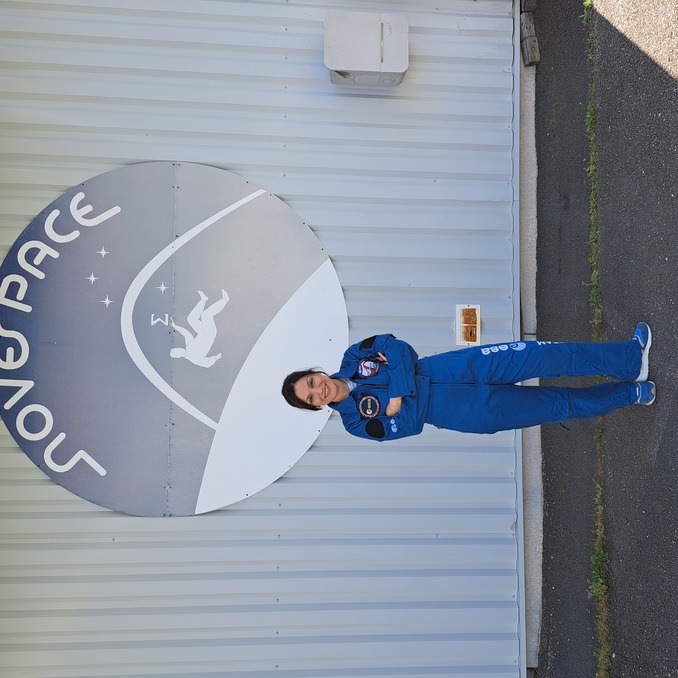How moondust becomes paving stones and roadsProf. Dr. Miranda Fateri from Aalen University is part of the research team of a project led by the European Space Agency

Prof. Dr. Miranda Fateri from Aalen University is part of a research team that is researching the construction of lunar roads from moon dust. © Aalen University | Sebastian Uhl
Dust is quite a nuisance. But on the moon it poses very special problems for the astronauts. Because the moon dust doesn't have much in common with the earth's fluff or dust: it is sharp-edged, fine and sticks like glue. Therefore, it can damage machines, devices and equipment. With the help of powerful laser beams, a research team including Prof. Dr. Miranda Fateri from Aalen University wants to turn dust into stone on the moon. The aim is to build roads and landing pads for future lunar missions. National and international media such as Spiegel online, BR 24, Times, Guardian and Nature recently reported on the ambitious project.
No one has set foot on the moon for over 50 years. Some countries are currently planning manned missions to the Earth's satellite again. However, lunar dust poses a significant risk. In a study in 2005, NASA classified dust as the greatest challenge for future lunar missions. The moon is partially covered by a layer up to 15 meters thick. This is so-called regolith, a powdered moon rock that looks more like sand than dust.
Riddled with broken glass
“Since there is no atmosphere on the moon – meaning no wind and no rain – there is no easy way to get rid of it. In addition, the individual particles are not rounded, but rather have very sharp edges. And the regolith is often riddled with glass fragments due to the heat from asteroid impacts,” explains Prof. Dr. Miranda Fateri from Aalen University. For example, seals on spacesuits, airlocks and even mechanical components can become contaminated. It also sticks to all surfaces thanks to its electrostatic charge. “This represents a significant problem for the exploration vehicles,” says Fateri, who teaches in the mechanical engineering/production and management course at Aalen University.
Together with Prof. Dr. Eckehard Kalhöfer, Tim Schubert and Juan-Carlos Ginés-Palomares, the young woman is part of a research team that is investigating the feasibility of building lunar roads. The PAVER (Paving the road for large area sintering of regolith) project is led by the European Space Agency (ESA), other cooperation partners include the Federal Institute for Materials Research and Testing (BAM), the LIQUIFER Systems Group Austria, the Clausthal University of Technology and the Institute for Materials Physics in Space of the German Aerospace Center (DLR).
First, promising attempts
“Our goal is to use lunar dust to produce solid materials for the lunar roads. As I said, there is more than enough dust on the moon. Unfortunately, we can’t take paving stones into space because the loading capacity of the rockets is too small,” says Fateri and laughs. The first laboratory tests have already been very promising. Artificial moon dust was melted using a high-power laser and processed into paving elements. “These had a strength close to that of concrete. This laser energy can be replaced by solar energy on the moon,” says Fateri enthusiastically. Of course, further research needs to be done to refine the process. “But we are on the right track and our results so far give hope that this technology can be reproduced on the moon,” says the researcher happily.
Great passion for space
She is proud that the ambitious research project was recently a big topic in many national and international media, such as Spiegel online or in the renowned Times and the English-language journal Nature. “But the moon and missions into space are also fascinating,” enthuses Fateri, whose great passion has been space for many years. “As a child, I always wondered what it looked like on the moon or Mars, whether we were alone in the universe or whether there were aliens, and then I read a lot about space,” says the 40-year-old, who grew up near the Caspian Sea in northern Iran. “The starry skies there are just incredible.”
Parabolic flight in France
This fascination also determined her professional path. She initially studied mechanical engineering at the University of Tehran. She came to Germany for a practical semester and then completed her master's degree in mechatronics at RWTH Aachen University. During her doctorate on the 3D printing process of glass materials, Fateri came up with the idea of using moon dust for 3D printing. “If we want to conduct research on the moon for a longer period of time, we need a way to produce components directly on site.” Through her work, ESA and DLR became aware of Fateri, where she continued her research after completing her doctorate. The young professor has been teaching and researching at Aalen University since 2019. She recently returned to France for a parabolic flight to carry out 3D experiments under the conditions of lunar and Martian gravity. “It’s an incredible feeling,” says Fateri enthusiastically.
“Research on the rise”
University Rector Prof. Dr. is also enthusiastic. Harald Riegel, who can still remember clearly when the first space shuttles were launched into space at the end of the 1970s and as a teenager he sat spellbound in front of the television. “The fact that we at Aalen University are now involved in space research with the PAVER project is simply sensational,” says Riegel happily, adding with a laugh: “It’s research at a high altitude, so to speak.”
